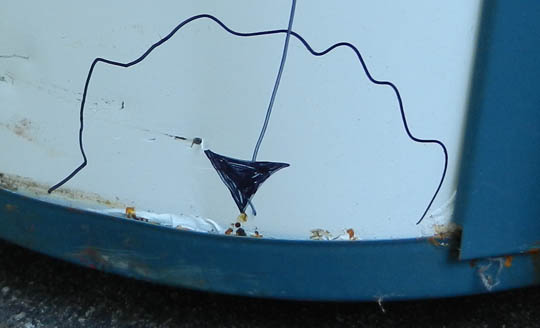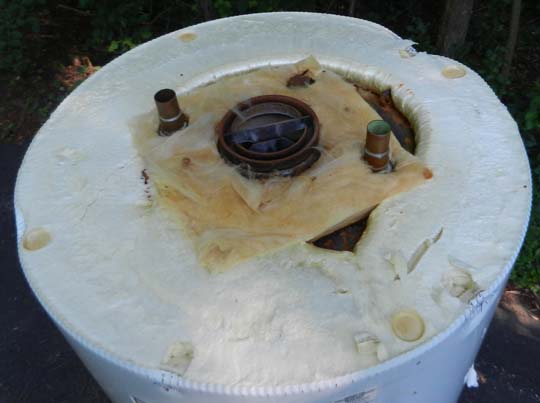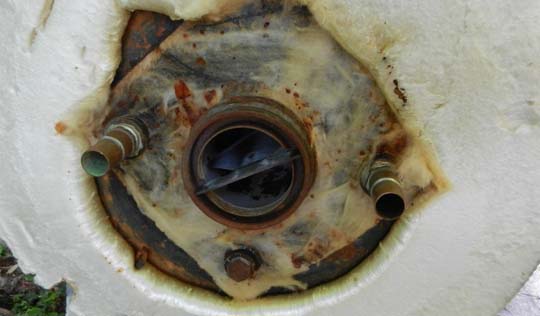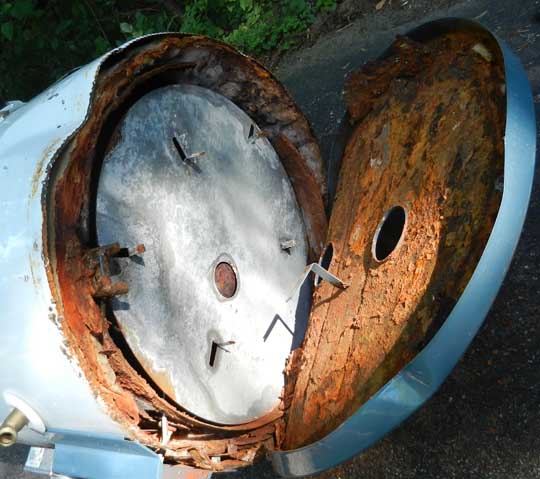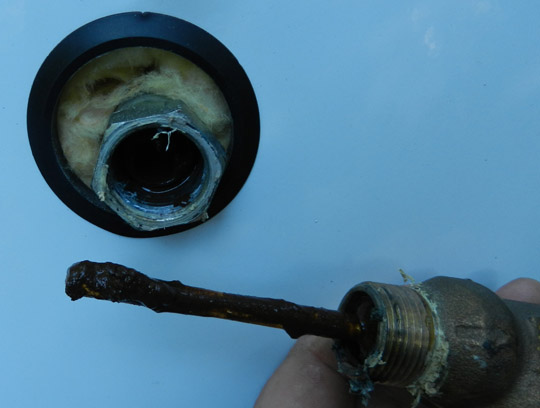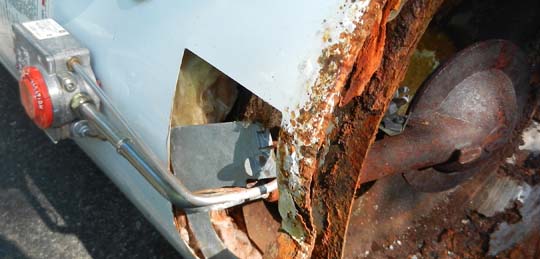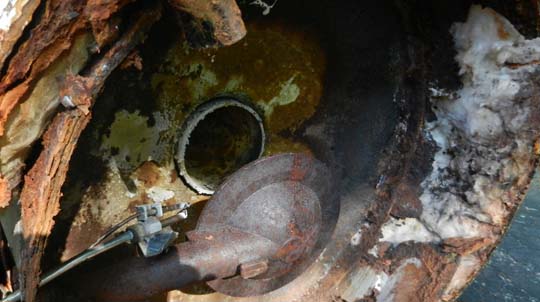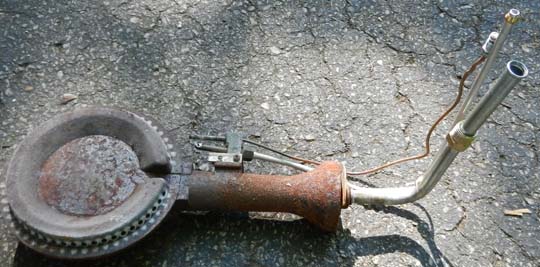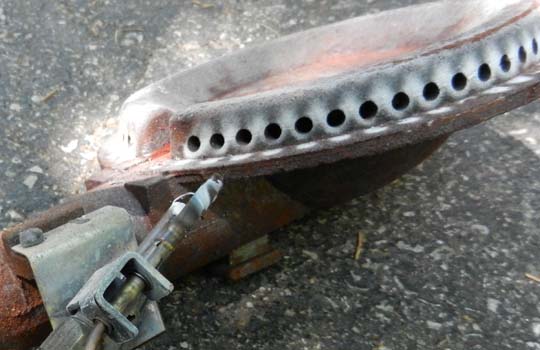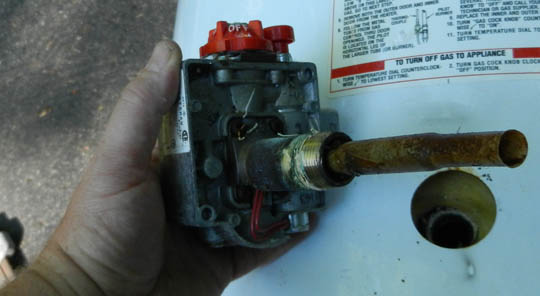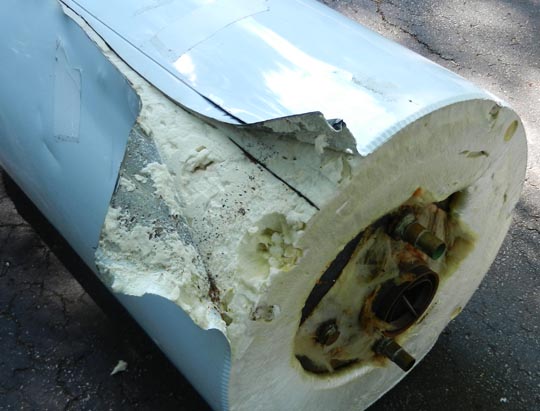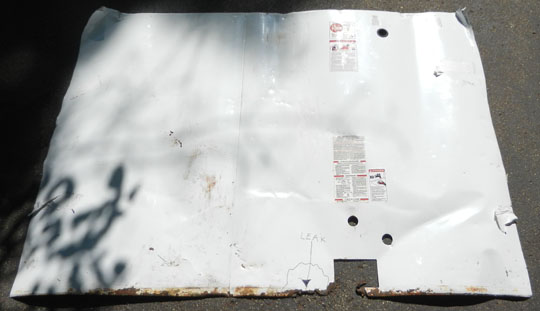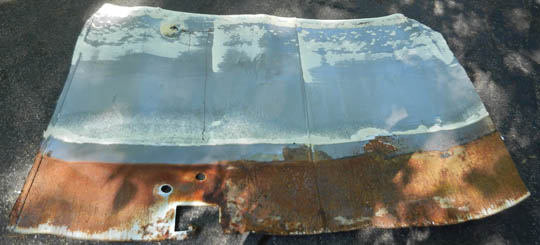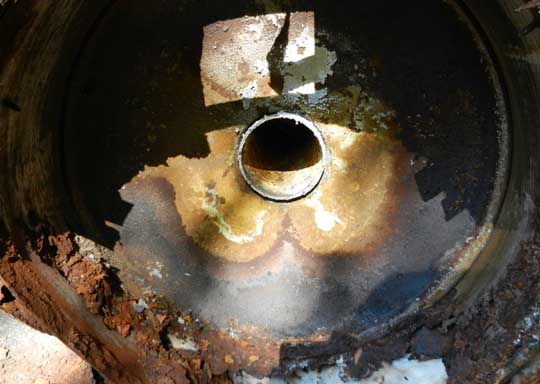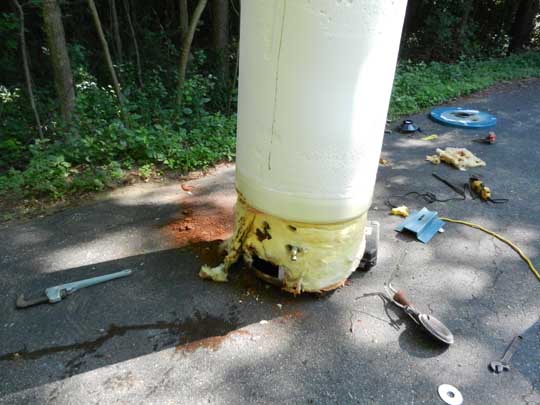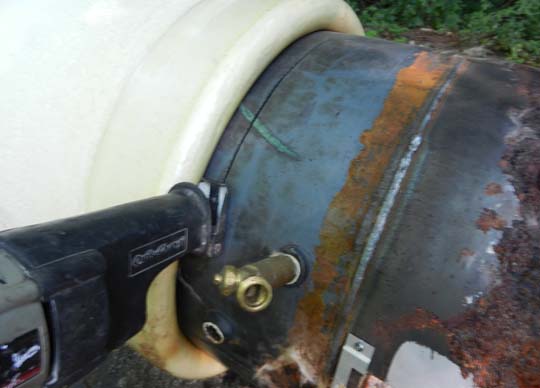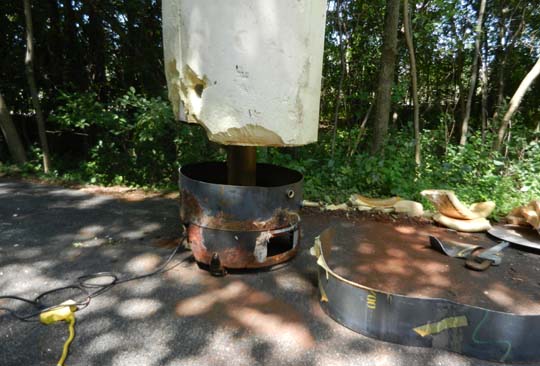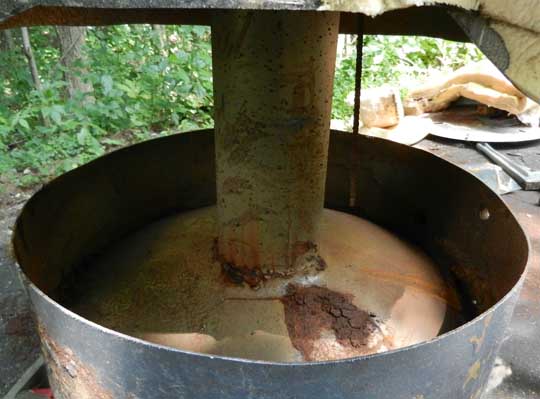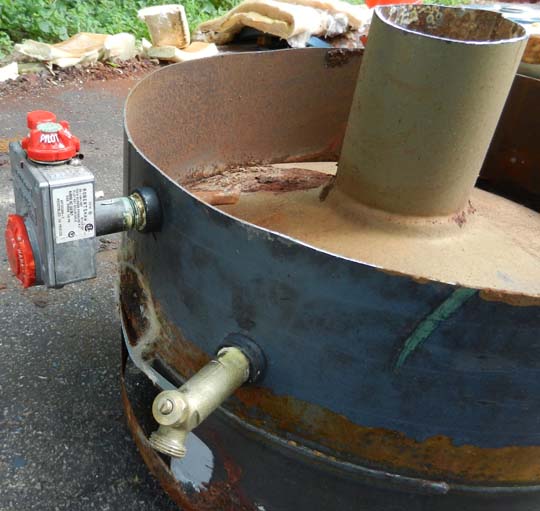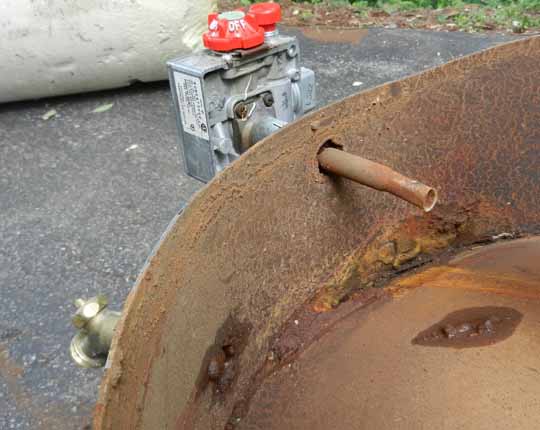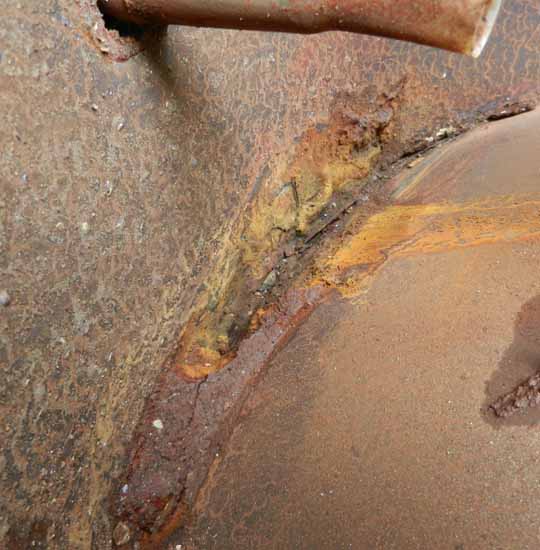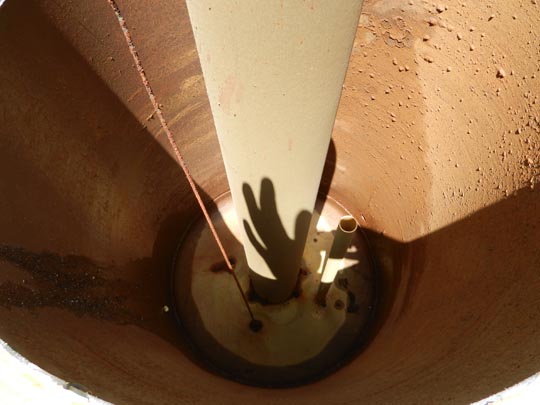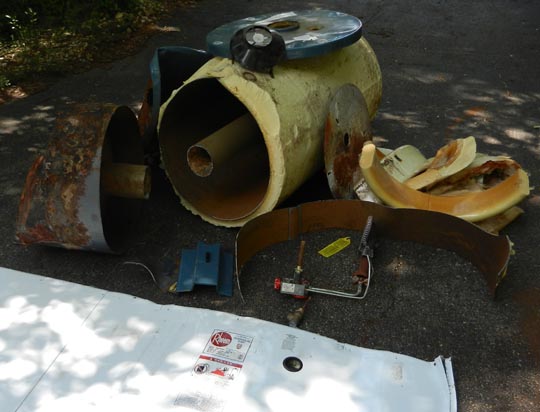Rare look inside a Rheem water heater!
Written by Mike Johnson in Design, Editorial, Repair, Reviews, Water
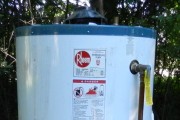
In this article I will completely disassemble a Rheem 75 gallon water heater
A customer in Hartland called me last week because his water heater was leaking. On the phone the customer told me it was leaking pretty bad so I was pretty sure I would be plumbing in a brand new water heater. When I arrived what I found was a Rheem 75 gallon natural gas water heater that was originally installed 13 years ago. After looking at it, it was obvious it couldn’t be repaired and had to be replaced.
Before I replaced the water heater Jason, the home owner, asked me where it was leaking from. When I explained it was the bottom of the tank he gave me a strange look and said “What does that actually look like inside”. I started to think about it and realized that most people have never really looked at the inside of a water heater before.
I love customer questions like this so after I installed the new water heater I dragged the old one home and decided to take it completely apart for my customers to see. This article is NOT about why a water heater fails, it’s simply an article that shows customers what a water heater looks like inside so they have first hand knowledge and are better equipped to understand what happens when they do leak.
When a water heater leaks it comes out the bottom pan
If you look at the photo below you can see where I took a marker and drew where the water leak appeared to be coming from. Let’s take it apart and see if the leak really does come from this spot.
To take apart a water heater the first step is to pop the top off like a can of soup
Here you can see how Rheem insulates everything, in this photo you can see the hot and cold supply, the anode rod, and the vent for the heat to escape.
This image is a close-up and shows where the raw steel tank meets the insulation.
The bottom of the water heater is the same as the top. The bottom tin plate is non-structural but the 3 legs you see in the photo are, and they are attached to the actual water tank.
Just like the top the bottom comes off like a soup can. Remember that this is the bottom of the water heater and that’s where the burner is. The grey colored plate you see is a heat shield and is catches debris that falls over the life span of the water heater. In the photo you can see lots of rust, most of it is from the support ring that’s welded to the actual tank itself. The rust was bad enough that one of the legs was completely rusted off the bottom rim and the water heater was mostly supported by the bottom blue cover.
Next the temperature and pressure valve needs to be removed, and it doesn’t look pretty. Normally it wouldn’t look this bad but my plumbing truck is a cube van and when I took it home I set the water heater on it’s side so the wet debris rolled around and attached itself to the RV.
The regulator and burner needs to be taken off next.
This is a close up of the burner before it’s removed. In this photo you are looking at the water heater from the bottom side. The hole you see is where the heat goes while it’s burning.
Here is the burner sitting in a similar position as it would be installed in the Rheem water heater. The burner is cast iron.
Below is a close-up of the thermocouple and burner from the side.
Before the metal jacket get taken off the last part to be removed is the gas regulator. This type of water heater has only one control. The part I’m holding has a main gas regulator, pilot gas regulator, on-off pilot knob, it controls water temperature, and has a temperature adjustment knob. A gas control unit is NOT something the homeowner should take apart!
Peel off the water heater jacket like a can of sardines. It’s actually really easy to take the metal jacket off, once I cut it with cut off wheel in a grinder it came apart in seconds.
Here is the metal jacket for the water heater, it lays down nice and flat.
Here is something you never see, it’s the backside of the metal water heater jacket. You can clearly see the rust line but that’s actually normal because it’s raw steel, the rusted area is where the burner is.
Well, before we chop the tank in half here is what the bottom of a Rheem water heater looks like with all the parts removed. You can see where the flames hit the bottom of the tank, the chimney vent, and of course the rust.
Here is the last photo of the water heater standing upright. The insulation is sprayed on most of it but the bottom portion is a special fiberglass batting used near the high temperature area of the burner.
Well lets get cutting hey? I have a few tools for this but I actually only used 2. This first tool is a sawzall with a metal cutting blade and the second tool is a 4″ disk grinder, the sawzall cut most of it apart. Do you remember the chimney in the photos of the top and bottom view of the water heater? The chimney is welded to the tank and sealed so cutting the water apart is a lot of work. The work starts but cutting all away around it in two spots then cutting the metal band in half so it can be removed. In the photo below you can also see that I left the boiler drain in the water heater. A boiler drain allows the heater to be drained and flushed out.
Take special notice of the weld bead that runs around the tank. To the right of the weld bead is just the area where the burner goes and it also gives the tank structural support while standing upright. To the left of the weld bead is the actual water tank.
As you can see in the photo the water heater is now standing upright with a section taken out. The next step in the process is to cut the inside chimney in half. Do you notice the rectangle where the burner enters the bottom of the water heater? In the very beginning of this article I circled a spot where it appeared the water heater was leaking but as you can see that has nothing whatsoever to do with where the tank is leaking. Once we cut it in half we can look inside and see what happened.
The next photo is where things start to get really interesting. Lets start with that wire you see hanging in the air, that’s what’s known as an anode rod. Unfortunately the wire you see hanging is just a wire, the anode rod is completely gone. Do you also see the spot under the anode rod? Well, that’s part of the remains of the anode rod. This article is about taking apart a water heater for inspection so I don’t want to go into detail about that here but I will be doing a special article in the future on just the anode rod and what purpose it serves.
Look at the hole near the top of the cut. The hole you see is where the gas regulator threaded into the tank. From the outside it look like it’s mounted pretty high up but once you cut it open you can see that it’s not that far from the bottom of the actual water tank. One more thing that’s interesting about this photo is the curved area of the tank bottom, as you can see this area can easily catch rust and debris.
This is simply a great photo of the water heater and shows a clear comparison of the inside to the outside. To better explain things I threaded the gas regulator back in so you can get a good feel for what it looks like. Do you see the boiler drain? Remember what that’s for? Now look at the weld. Remember how the weld is the actual bottom of the tank? Do you see a problem here?
All water heater manufactures do this and it’s a very poor design. We can talk about this in a different article but it’s worth mentioning that draining the sediment out of a water heater can sometimes be impossible because of the location of the boiler drain. You can also see in the photo where the side wall of the tank meets the bottom edge of the tank. This joint slowly fills up with sediment and eventually becomes a serious problem for the longevity of the water heater.
This is the inside and you can see the boiler drain and how high it is off the bottom of the tank. You can tell by the photo that draining a water heater and flushing it out can be an issue. Did you notice the build up of sediment in the bottom seam of the tank? According to what the photo reveals this has been building up for many years. This is the culprit, this is what caused the water heater to fail. One thing to keep in mind is that many new water heaters come with plastic boiler drains to save on cost. Plastic boiler drains do break, and when they break it’s very hard to retrieve and repair it properly.
Below is a close up shot of the sediment built up at the bottom of the water heater.
This is the last photo of the inside of the water heater. The photo below is actually the top of the water heater, I tipped it over so the sun would shine inside for a better picture. This photo shows the anode rod, or what’s left of it. The photo also shows pitting in the side walls. This pitting is what happens AFTER the anode rod was consumed.
The last item is the dip tube, that’s the cream looking plastic tube you see poking up. The dip tube is on the cold side and it forces water towards the bottom of the tank where it gets heated.
That’s it, we took the entire water heater apart and had a rare opportunity to look inside. The photo below is the pile of parts when the project was finished.
Summary
I spent a great deal of time cutting apart the water heater and writing up this article. My goal is to educate YOU, the customer. It’s sometimes difficult for consumers to fully understand what a plumber does day in and day out. I hope this article gave you a little more insight into how a water heater works and some of the issues we face. It also gives you a better understanding of why water heaters fail.
Some people may think 13 years is a long time for a water heater, after all a standard warranty is 6 – 8 years. The truth is this, the warranty is what the manufactures calculate to be safe if the homeowner does ZERO maintenance. It’s unfortunate but the reality is, once most water heaters are installed maintenance gets forgot about. What if I told you that a water heater might last 15-20 years?
Water heaters need to be flushed and maintained, they need the anode rod replaced, and they need to be taken care of. The water heater you watched being taken apart lasted 13 years with ZERO maintenance. It had never had the anode rod replaced and it had never been flushed.
In the article you saw all the sediment built up over a 13 year period, imagine if it had been flushed only 2 times in it’s career as a heater.
Conclusion
Oconomowoc Plumbing is a small company that takes great pride in plumbing. If you need a water heater replaced, cleaned, flushed, or the anode rod replaced you can call me direct on my cell phone @ 920-988-0014. If you think you can do it yourself be sure to post your question and I will answer them for you. What’s most important is that the job is done safely and done right.
Mike Johnson

